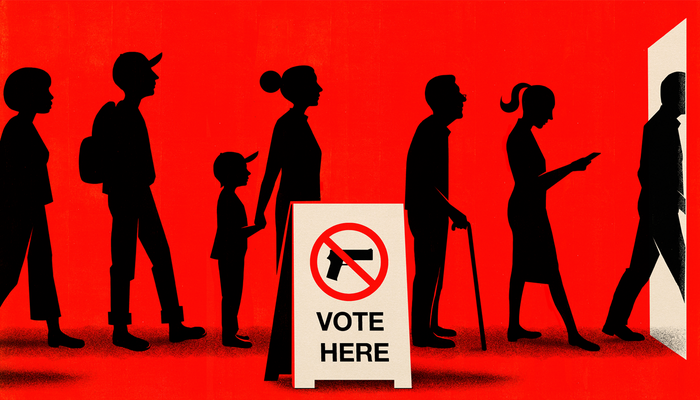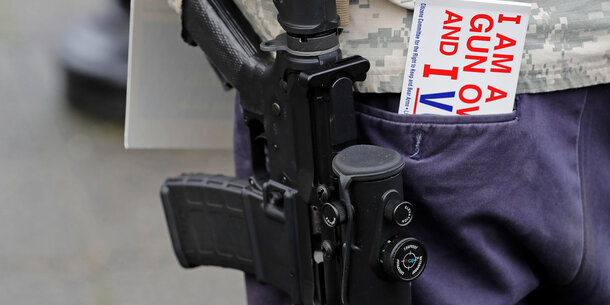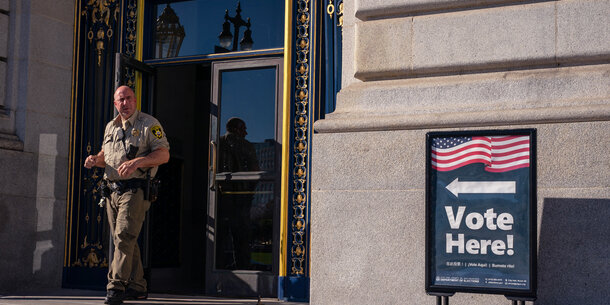Since this report was released, a number of states have enacted laws prohibiting guns at election locations. An updated chart summarizing state prohibitions is here.
Over the last 20 years, several distinct developments have increased the risk of gun violence in American elections. A marked shift in the U.S. Supreme Court’s approach to the Second Amendment and an aggressive pro-gun movement have caused significant deregulation of guns in some states and cast a shadow of legal uncertainty on strong gun regulations in others. Moreover, as the political system has grown more polarized and prone to violence, politicians have spread disinformation about voting rules to sow distrust in our democracy.
The result: voting and elections have become the targets of threats and intimidation just as the nation faces a proliferation of guns, more frequent gun violence, and fewer legal protections. This is a toxic combination. Still, most states’ laws do not adequately protect voters or the election system.
The 2024 election will unfold in a transformed legal environment. In a majority of states, gun advocates have successfully pushed deregulation of firearms in legislatures and the courts. In 2010, only two states let people carry concealed firearms in public without a permit or background check. Now, 27 states allow “permitless carry.” While other states have strengthened gun regulations during this period, the Supreme Court has threatened their ability to do so. Last year, in New York State Rifle & Pistol Association, Inc. v. Bruen, the Court forced the six states with the strongest concealed carry laws, as well as Washington, DC, to weaken their restrictions.1 And it announced an entirely new test for evaluating the constitutionality of gun regulations, inviting a wave of litigation. Courts have already issued more than 450 decisions analyzing Bruen in Second Amendment challenges to gun laws.2
In this environment, guns have proliferated. The United States now has more guns than people. In 2020 and 2021, the social unrest caused by the pandemic, unprecedented racial justice protests, and the presidential election and its aftermath drove gun purchasing to record levels — more than 42 million guns were sold in those two years alone. Violence rose. Compared with historical averages, the period between March 1, 2020, and February 28, 2021, saw a 15 percent increase in firearm-related incidents, a 34 percent increase in nonfatal gun injuries, and a 28 percent increase in gun deaths.3 Then, in 2022, applications for permits to carry guns in public in the states directly affected by Bruen sharply increased. In the first three weeks following the decision, applications in Maryland rose to 700 percent of the level that they had been the year prior.4
Meanwhile, American democracy has been facing new and unnerving pressure as the result of a growing election denial movement. In 2020, states expanded voting by mail and early voting due to the coronavirus pandemic. Endeavoring to overturn the results of the 2020 presidential election, then President Donald Trump and his allies launched massive disinformation campaigns targeting this expanded access to voting, claiming that the election was “rigged” and that election administration officials were engaged in fraud. This election denial movement has spread beyond Trump and reached into state and local elections, fueled by conspiracy theories about mail voting, drop boxes, election officials, poll workers, and ballot counting.
From its inception, threats of political violence marked this movement. The most prominent example, of course, was the January 6, 2021, attack on the U.S. Capitol. But even in the hours and days immediately following the 2020 election, armed protesters gathered outside ballot-counting facilities. And in the years since, election officials and poll workers have come under attack, experiencing a shocking volume of threats, including threats of gun violence. Voters as well have faced novel forms of intimidation, including armed surveillance of drop boxes.
With more guns and more political polarization and violence, states need strong laws to limit risk. In Bruen, the Supreme Court recognized that prohibitions on guns in “sensitive places” — and specifically in “polling places” — were “presumptively lawful.” Yet today only 12 states and Washington, DC, prohibit both open and concealed carry of firearms at poll sites. Ironically, the states with the strongest gun regulations — which had restricted the ability to carry guns in public generally, rather than prohibiting guns in particular locations — were made most vulnerable in the wake of Bruen. In fact, only one of the six states that had their laws struck down by the decision specifically prohibited guns in polling places at the time of the decision.
Now these states that once had strong general gun laws must scramble to enact new protections for elections. Although some states have banned guns at polling places since Bruen, there is far more work to do.
This report evaluates the new risks that gun violence poses for U.S. elections and proposes policy solutions to limit those risks. Solutions include prohibitions on firearms wherever voting or election administration occurs — at or near polling places, ballot drop boxes, election offices, and ballot counting facilities. In addition, states need stronger laws preventing intimidation of voters, election officials, election workers, and anyone else facilitating voting, with express recognition of the role that guns play in intimidation.
American elections remain, by and large, peaceful. To keep them that way, state legislatures must keep guns away from voting.
This report was amended on September 28, 2023, to include Washington among the states that prohibit open carry of firearms in polling places.
Endnotes
-
1
New York State Rifle & Pistol Association, Inc. v. Bruen, 142 S. Ct. 2111 (2022). -
2
Billy Clark, “Second Amendment Challenges Following the Supreme Court’s Bruen Decision,” Giffords Law Center, June 21, 2023, https://giffords.org/lawcenter/memo/second-amendment-challenges-following-the-supreme-courts-bruen-decision/. -
3
The comparison period was from January 1, 2016, to February 29, 2020. Shengzhi Sun et al., “Analysis of Firearm Violence During the COVID-19 Pandemic in the US,” JAMA Network Open, April 28, 2022, https://jamanetwork.com/journals/jamanetworkopen/fullarticle/2791600. -
4
Walter Morris, “Concealed Carry Permit Applications Soar in Maryland,” NBC Washington, July 12, 2022, https://www.nbcwashington.com/news/local/concealed-carry-permit-applications-soar-in-maryland/3098367/.




